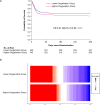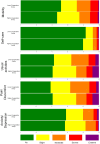Long-term mortality and health-related quality of life with lower versus higher oxygenation targets in intensive care unit patients with COVID-19 and severe hypoxaemia
- PMID: 39235624
- PMCID: PMC11446942
- DOI: 10.1007/s00134-024-07613-2
Long-term mortality and health-related quality of life with lower versus higher oxygenation targets in intensive care unit patients with COVID-19 and severe hypoxaemia
Abstract
Purpose: The aim of this study was to evaluate one-year outcomes of lower versus higher oxygenation targets in intensive care unit (ICU) patients with coronavirus disease 2019 (COVID-19) and severe hypoxaemia.
Methods: We conducted pre-planned analyses of one-year mortality and health-related quality of life (HRQoL) in the Handling Oxygenation Targets in COVID-19 trial. The trial randomised 726 ICU patients with COVID-19 and hypoxaemia to partial pressure of arterial oxygen targets of 8 kPa (60 mmHg) versus 12 kPa (90 mmHg) during ICU stay up to 90 days, including readmissions. HRQoL was assessed using EuroQol visual analogue scale (EQ-VAS) and 5-level 5-dimension questionnaire (EQ-5D-5L). Outcomes were analysed in the intention-to-treat population. Non-survivors were assigned the worst possible score (zero), and multiple imputation was applied for missing EQ-VAS values.
Results: We obtained one-year vital status for 691/726 (95.2%) of patients and HRQoL data for 642/726 (88.4%). At one year, 117/348 (33.6%) of patients in the lower-oxygenation group had died compared to 134/343 (39.1%) in the higher-oxygenation group (adjusted risk ratio: 0.85; 98.6% confidence interval (CI) 0.66-1.09; p = 0.11). Median EQ-VAS was 50 (interquartile range, 0-80) versus 40 (0-75) (adjusted mean difference: 4.8; 98.6% CI - 2.2 to 11.9; p = 0.09) and EQ-5D-5L index values were 0.61 (0-0.81) in the lower-oxygenation group versus 0.43 (0-0.79) (p = 0.20) in the higher-oxygenation group, respectively.
Conclusion: Among adult ICU patients with COVID-19 and severe hypoxaemia, one-year mortality results were most compatible with benefit of the lower oxygenation target, which did not appear to result in more survivors with poor quality of life.
Keywords: COVID-19; Intensive care units; Mortality; Oxygen inhalation therapy; Quality of life.
© 2024. The Author(s).
Conflict of interest statement
The Department of Intensive Care at Rigshospitalet (AP, MNK) received funding from Sygeforsikringen “Danmark”, The Novo Nordisk Foundation, the Ehrenreich Foundation, the Becketts Foundation, and AM-Pharma. TL has served in Data and Safety Monitoring Board for Novo Nordisk and Leo Pharma, respectively: the studies were unrelated to the present study.
Figures



References
-
- Alhazzani W, Evans L, Alshamsi F, Moller MH, Ostermann M, Prescott HC et al (2021) Surviving sepsis campaign guidelines on the management of adults with coronavirus disease 2019 (COVID-19) in the ICU: first update. Crit Care Med 49(3):e219–e234. 10.1097/CCM.0000000000004899 - PubMed
-
- Schjørring OL, Klitgaard TL, Perner A, Wetterslev J, Lange T, Siegemund M et al (2021) Lower or higher oxygenation targets for acute hypoxemic respiratory failure. N Engl J Med 384(14):1301–1311. 10.1056/NEJMoa2032510 - PubMed
-
- van der Wal LI, Grim CCA, Del Prado MR, van Westerloo DJ, Boerma EC, Rijnhart-de Jong HC et al (2023) Conservative versus liberal oxygenation targets in intensive care unit patients (ICONIC): a randomized clinical trial. Am J Respir Crit Care Med 208(7):770–779. 10.1164/rccm.202303-0560OC - PMC - PubMed
-
- Klitgaard TL, Schjørring OL, Nielsen FM, Meyhoff CS, Perner A, Wetterslev J et al (2023) Higher versus lower fractions of inspired oxygen or targets of arterial oxygenation for adults admitted to the intensive care unit. Cochrane Database Syst Rev 9(9):Cd012631. 10.1002/14651858.CD012631.pub3 - PMC - PubMed
Publication types
MeSH terms
Substances
LinkOut - more resources
Full Text Sources
Medical

